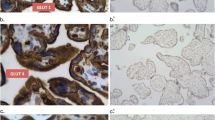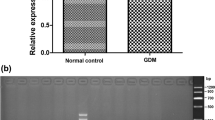Abstract
Purpose
The prevalence of diabetic disorders in pregnancy is rising, which goes along with increased risks for maternal and foetal complications during pregnancy and delivery. The expression of the endo-β-d-glucuronidase, heparanase (HPSE), may increase under hyperglycaemic conditions, is believed to play an important role in diabetes associated morbidity outside the female reproductive tract and is expressed in the placenta throughout gestation. However, the placental expression of HPSE has not been investigated in diabetic patients.
Materials and methods
Placental biopsies of 30 patients with pre-existing or gestational diabetes and 30 healthy controls were analysed by real-time PCR and immunohistochemistry with regard to the presence of HPSE at term.
Results
Patients and controls were comparable with respect to foetal outcome and maternal characteristics except for maternal body mass index. We were unable to show significant differences in placental HPSE expression between diabetic patients and healthy controls.
Discussion
This study suggests that HPSE expression in term placentas is not affected by maternal diabetes and thus does not contribute to pathological processes in diabetic pregnancies with deliveries at term.

Similar content being viewed by others
References
Horvath K, Koch K, Jeitler K, Matyas E, Bender R, Bastian H, Lange S, Siebenhofer A (2010) Effects of treatment in women with gestational diabetes mellitus: systematic review and meta-analysis. BMJ 340:c1395
Ferrara A (2007) Increasing prevalence of gestational diabetes mellitus: a public health perspective. Diabetes Care 30(Suppl 2):141S–146S
Bloomgarden ZT (2010) Gestational diabetes mellitus and obesity. Diabetes Care 33:e60–e65
Vlodavsky I, Friedmann Y (2001) Molecular properties and involvement of heparanase in cancer metastasis and angiogenesis. J Clin Invest 108:341–347
Nadir Y, Henig I, Naroditzky I, Paz B, Vlodavsky I, Brenner B (2010) Involvement of heparanase in early pregnancy losses. Thromb Res 125:e251–e257
Klein U, Von Figura K (1976) Partial purification and characterization of heparan sulfate specific endoglucuronidase. Biochem Biophys Res Commun 73:569–576
Haimov-Kochman R, Friedmann Y, Prus D, Goldman-Wohl DS, Greenfield C, Anteby EY, Aviv A, Vlodavsky I, Yagel S (2002) Localization of heparanase in normal and pathological human placenta. Mol Hum Reprod 8:566–573
Miles JR, Vallet JL, Freking BA, Nonneman DJ (2009) Molecular cloning and characterisation of heparanase mRNA in the porcine placenta throughout gestation. Reprod Fertil Dev 21:757–772
Kirn-Safran CB, D’Souza SS, Carson DD (2008) Heparan sulfate proteoglycans and their binding proteins in embryo implantation and placentation. Semin Cell Dev Biol 19:187–193
Parish CR, Freeman C, Hulett MD (2001) Heparanase: a key enzyme involved in cell invasion. Biochim Biophys Acta 1471:M99–M108
Katz A, Van-Dijk DJ, Aingorn H, Erman A, Davies M, Darmon D, Hurvitz H, Vlodavsky I (2002) Involvement of human heparanase in the pathogenesis of diabetic nephropathy. Isr Med Assoc J 4:996–1002
Waterman M, Ben-Izhak O, Eliakim R, Groisman G, Vlodavsky I, Ilan N (2007) Heparanase upregulation by colonic epithelium in inflammatory bowel disease. Mod Pathol 20:8–14
Vreys V, David G (2007) Mammalian heparanase: what is the message? J Cell Mol Med 11:427–452
Maxhimer JB, Somenek M, Rao G, Pesce CE, Baldwin D Jr, Gattuso P, Schwartz MM, Lewis EJ, Prinz RA, Xu X (2005) Heparanase-1 gene expression and regulation by high glucose in renal epithelial cells: a potential role in the pathogenesis of proteinuria in diabetic patients. Diabetes 54:2172–2178
Lewis EJ, Xu X (2008) Abnormal glomerular permeability characteristics in diabetic nephropathy: implications for the therapeutic use of low-molecular weight heparin. Diabetes Care 31(Suppl 2):S202–S207
van den Hoven MJ, Rops AL, Vlodavsky I, Levidiotis V, Berden JH, van der Vlag J (2007) Heparanase in glomerular diseases. Kidney Int 72:543–548
Grissa O, Yessoufou A, Mrisak I, Hichami A, Amoussou-Guenou D, Grissa A, Djrolo F, Moutairou K, Miled A, Khairi H, Zaouali M, Bougmiza I, Zbidi A, Tabka Z, Khan NA (2010) Growth factor concentrations and their placental mRNA expression are modulated in gestational diabetes mellitus: possible interactions with macrosomia. BMC Pregnancy Childbirth 10:7
Holdsworth-Carson SJ, Lim R, Mitton A, Whitehead C, Rice GE, Permezel M, Lappas M (2010) Peroxisome proliferator-activated receptors are altered in pathologies of the human placenta: gestational diabetes mellitus, intrauterine growth restriction and preeclampsia. Placenta 31:222–229
Colomiere M, Permezel M, Riley C, Desoye G, Lappas M (2009) Defective insulin signaling in placenta from pregnancies complicated by gestational diabetes mellitus. Eur J Endocrinol 160:567–578
Pfaffl MW (2001) A new mathematical model for relative quantification in real-time RT-PCR. Nucleic Acids Res 29:e45
Bohlmann MK, Luedders DW, Strowitzki T, von Wolff M (2010) Specific secretory phase endometrial leukocytes of women with two and more consecutive idiopathic abortions are not significantly different from healthy controls. Arch Gynecol Obstet 281:983–990
Goshen R, Hochberg AA, Korner G, Levy E, Ishai-Michaeli R, Elkin M, de Groot N, Vlodavsky I (1996) Purification and characterization of placental heparanase and its expression by cultured cytotrophoblasts. Mol Hum Reprod 2:679–684
Dempsey LA, Plummer TB, Coombes SL, Platt JL (2000) Heparanase expression in invasive trophoblasts and acute vascular damage. Glycobiology 10:467–475
Harris LK, Baker PN, Brenchley PE, Aplin JD (2008) Trophoblast-derived heparanase is not required for invasion. Placenta 29:332–337
Acknowledgments
The authors wish to thank Drs. Thorben Ahrens, Kristin Baumann, Schima Djalali, David Hartge, Friederike Hoellen and Katharina Kelling for their help in the collection of placental tissue. We would furthermore like to thank Stephan Polack, who contributed substantially to the accurate performance of the experiments.
Conflict of interest
None.
Author information
Authors and Affiliations
Corresponding author
Additional information
An erratum to this article can be found at http://dx.doi.org/10.1007/s00404-010-1729-1
Rights and permissions
About this article
Cite this article
Luedders, D.W., Bundschuh, D., Hornemann, A. et al. Heparanase expression in term placentas of diabetic patients and healthy controls. Arch Gynecol Obstet 284, 287–292 (2011). https://doi.org/10.1007/s00404-010-1636-5
Received:
Accepted:
Published:
Issue Date:
DOI: https://doi.org/10.1007/s00404-010-1636-5




